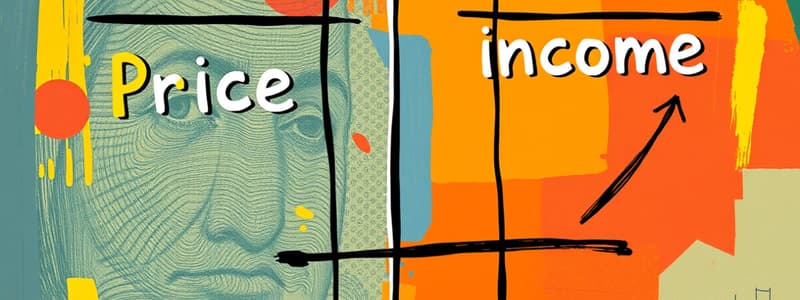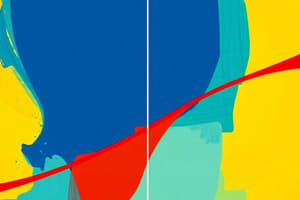Podcast
Questions and Answers
How does the law of demand describe the relationship between price and quantity demanded?
How does the law of demand describe the relationship between price and quantity demanded?
- Quantity demanded changes independently of price.
- The quantity demanded increases at a constant rate with increasing prices.
- An increase in price results in a decrease in quantity demanded. (correct)
- An increase in price results in an increase in quantity demanded.
Which of the following best explains the influence of diminishing marginal utility on consumer behavior?
Which of the following best explains the influence of diminishing marginal utility on consumer behavior?
- Consumers prioritize less urgent needs first.
- Consumers derive more satisfaction from each additional unit purchased.
- Consumers will purchase unlimited quantities regardless of price.
- The first units of goods satisfy the most urgent needs of consumers. (correct)
What could cause a shift in the demand curve rather than a movement along it?
What could cause a shift in the demand curve rather than a movement along it?
- A change in the price of the good itself.
- A change in the quantity supplied in the market.
- A change in consumer preferences. (correct)
- A change in the price of related goods. (correct)
What does price elasticity of demand measure?
What does price elasticity of demand measure?
Which scenario depicts the concept of substitutes in demand?
Which scenario depicts the concept of substitutes in demand?
What effect do complements have on demand?
What effect do complements have on demand?
How do consumer expectations influence demand?
How do consumer expectations influence demand?
Which statement about market demand curves is true?
Which statement about market demand curves is true?
How does the availability of substitutes influence price elasticity of demand?
How does the availability of substitutes influence price elasticity of demand?
What does derived demand signify?
What does derived demand signify?
In understanding cross-price elasticity of demand, a positive value indicates that goods are classified as what?
In understanding cross-price elasticity of demand, a positive value indicates that goods are classified as what?
What type of demand is characterized by the need for additional resources to produce a single good?
What type of demand is characterized by the need for additional resources to produce a single good?
What does a unitary elastic price elasticity of demand mean?
What does a unitary elastic price elasticity of demand mean?
Which of the following represents a good that exhibits income elastic demand?
Which of the following represents a good that exhibits income elastic demand?
What is defined as composite demand?
What is defined as composite demand?
Which of these is an example of cross demand?
Which of these is an example of cross demand?
What does an increase in consumer incomes generally lead to in terms of demand?
What does an increase in consumer incomes generally lead to in terms of demand?
How do close substitutes affect the demand for a given economic good?
How do close substitutes affect the demand for a given economic good?
What characterizes elastic demand?
What characterizes elastic demand?
What is the primary determinant of the law of demand?
What is the primary determinant of the law of demand?
What effect do complementary goods have on the demand of a particular good?
What effect do complementary goods have on the demand of a particular good?
What relationship does the law of demand demonstrate?
What relationship does the law of demand demonstrate?
When the price of a good decreases, what is the expected change in demand according to consumer behavior?
When the price of a good decreases, what is the expected change in demand according to consumer behavior?
Which factor is considered a determinant of demand?
Which factor is considered a determinant of demand?
Flashcards are hidden until you start studying
Study Notes
Types of Demand
- Price Demand: Quantities of goods/services consumers will buy at a specific price, assuming other factors remain constant.
- Income Demand: Quantities of goods/services demanded at varying income levels, with all else held constant.
- Cross Demand: Demand for a product influenced by the price of related goods rather than its own price.
- Direct Demand: Demand for goods/services that satisfy an individual's needs immediately.
- Derived (Indirect) Demand: Demand for goods/services needed to produce other goods, fulfilling consumer needs indirectly.
- Joint Demand: Demand for multiple interconnected products necessary for producing a single item (e.g., oven, flour for bread).
- Composite Demand: Goods/services utilized for various purposes simultaneously (e.g., coal for energy and steel production).
Price, Income, and Cross Elasticities
- Price Elasticity of Demand (PED): Measures how quantity demanded responds to price changes.
- Income Elasticity of Demand (YED): Measures how quantity demanded changes in response to income variations.
- Cross Price Elasticity of Demand (XED): Assesses how the quantity demanded for one good reacts to the change in price of another good.
Numerical Values Interpretation
- PED Types:
- Unitary Elastic: Proportional change in demand with price changes.
- Perfectly Elastic: Infinite sensitivity to price changes.
- Relatively Elastic: Significant sensitivity to price changes.
- Perfectly Inelastic: No change in demand regardless of price changes.
- Relatively Inelastic: Minimal sensitivity to price changes.
- YED Types:
- Inferior Goods: Demand decreases as income increases.
- Normal Goods: Demand increases with income.
- Luxury Goods: Demand increases more than proportionally with income.
- XED Types:
- Substitutes: Positive elasticity; an increase in the price of one increases demand for the other.
- Complementaries: Negative elasticity; an increase in price of one decreases demand for the other.
- Unrelated Goods: Zero elasticity; changes in price of one do not affect demand for the other.
Factors Influencing Price Elasticities
- Availability of Substitutes: More substitutes tend to make demand more elastic as consumers can easily switch.
- Complementary Goods: The presence of complementary goods can increase demand.
- Consumer Preferences: Changes in preferences can shift demand curves.
- Income Levels: Rising incomes generally increase demand for normal goods.
Law of Demand
- Inverse Relationship: As prices rise, quantity demanded falls; as prices drop, quantity demanded increases.
- Diminishing Marginal Utility: Consumers prioritize the use of goods to satisfy their most urgent needs first.
- Demand Curve: Visually represents the quantity demanded at various price levels, demonstrating the inverse relationship between price and demand.
- Market Demand Curve: Aggregates individual demand at various prices across all consumers.
Determinants of Demand
- Price of the Product: Critical parameter influencing consumer decisions; follows the law of demand.
- Demand Curve/Schedule: Tools to visualize and analyze quantity demanded at specific price points.
- Elastic vs. Inelastic Demand: Elastic demand signifies significant changes with price shifts, while inelastic indicates minimal responsive changes.
General Understanding
- Economics studies the allocation of scarce resources to satisfy unlimited wants.
- The law of demand is fundamental in explaining market behaviors, showing how price alterations affect consumer demand.
Studying That Suits You
Use AI to generate personalized quizzes and flashcards to suit your learning preferences.




